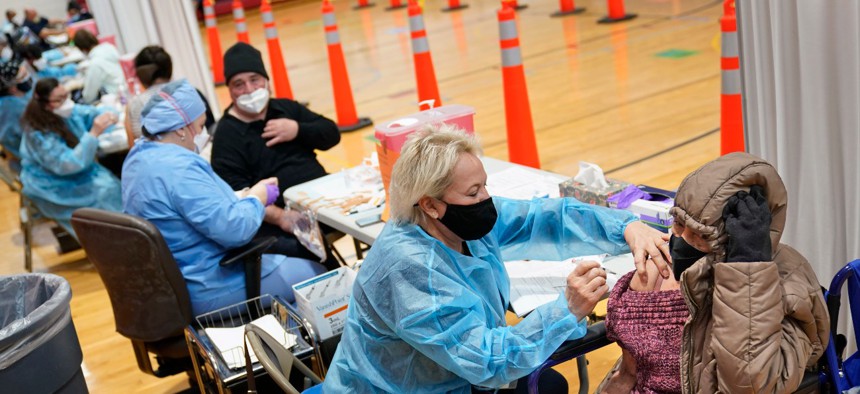
Miriam Palomino, right, received the COVID-19 vaccine in Paterson, N.J., Thursday, Jan. 21, 2021. The first people arrived around 2:30 a.m. for the chance to be vaccinated at one of the few sites that does not require an appointment. Seth Wenig/AP
VA Expands Vaccination to Some Non-Health Care Staff as Postal Workers Face Uncertainty
Agencies have started vaccinations for more than 1 million people, but many federal workers have not received clear guidance.
The Veterans Affairs Department has begun vaccinating employees beyond the front lines of health care against COVID-19, moving to a second tier of inoculations as other federal agencies struggle to inform workers whether they will be able to help them receive the shots at all.
VA has delivered at least one dose of the vaccine to 222,000 employees, mostly to its 250,000-person clinical workforce. At some facilities, according to multiple employees, administrative staff, such as those in IT or human resources, have begun receiving the shots. VA has administered at least one dose to nearly 600,000 people total after opening up the inoculation program to most veterans older than 75 or otherwise at severe risk of illness if they contract the novel coronavirus.
U.S. Postal Service employees, meanwhile, are still searching for answers on how and when they will receive a vaccine. A Centers for Disease Control and Prevention panel last month recommended USPS workers be included in Phase 1B of the distribution plan, after health care workers and long-term care residents. USPS has said the decision is ultimately up to states, however, and there has yet to be any scaled effort to vaccinate postal workers specifically even as states have advanced to the relevant distribution stage.
Ohio has moved into Phase-1B of distribution, for example, but has primarily focused on older citizens and those with preexisting conditions. Still, a lack of communication has left employees confused.
“It just seems like we got skipped over,” said a letter carrier based in Cincinnati, “and we’re not exactly a small group of people.”
A postal worker in Washington, D.C., said his management provided no updated information other than that he and his colleagues would be eligible when other “essential workers” can also receive their shots.
In a message to workers last week, USPS encouraged its staff to seek the vaccine by any means available. They cautioned their employees against waiting to get a shot through their workplace. Still, behind the scenes postal management is working with states and other jurisdictions receiving vaccine distributions to set up mass vaccination events at their large plants.
“If there are no technical obstacles, we think there is a good chance they are implemented right into the workplace,” said Mark Dimondstein, president of the American Postal Workers Union, who is involved in discussions with Postal Service management to arrange for such an initiative. In post offices with only a few employees, Dimondstein wants to make it as easy as possible for those workers to go elsewhere to receive their shots.
The Postal Service is not expected to be able to purchase or be provided its own allotments of vaccine—as VA, the departments of Defense and State, the Indian Health Service and the Bureau of Prisons have been—so its leadership is currently working with state health departments to potentially set up worksite vaccination events.
“The U.S. Postal Service continues to work toward a standardized priority opportunity for our employees who choose to get the COVID-19 vaccine,” said Mauresa Pittman, a USPS spokeswoman. “The Postal Service has done so by working with federal, state and local stakeholders to develop a nationwide COVID-19 vaccine distribution plan for postal employees.”
Pittman emphasized, however, that employees should stay abreast of the vaccination plans in their home states and get an inoculation “at the first opportunity available to them.”
So far, Dimondstein said, the chaotic rollout has made it impossible to know whether any postal workers have been vaccinated. Some states, he noted, have broken with the CDC’s recommendation and moved postal workers down on the priority list. Dimondstein has written to governors in those states, such as Gov. Andrew Cuomo, D-N.Y., urging them to reconsider those decisions.
“Postal workers have been out there as essential workers,” he said. “Like every other essential worker, they now need to be treated as such.”
All together, federal agencies have at least started vaccinations for more than 1 million people. That figure includes non-federal staff, such as veterans and those receiving care through IHS, as well as military personnel. In what could perhaps become a model for USPS or other federal agencies with frontline personnel, VA has begun vaccinating Homeland Security Department employees. President Biden has also floated the possibility of opening up VA facilities to vaccinate non-veteran, non-employee individuals.
VA has said it hopes to eventually offer vaccines to its entire workforce, but has not yet set up a timetable for reaching that goal. The department has not opened up inoculations to its entire workforce. One Veterans Benefits Administration worker said management has not yet said when he would be eligible, but noted it is "pushing" to make shots available for those in public-facing positions.







